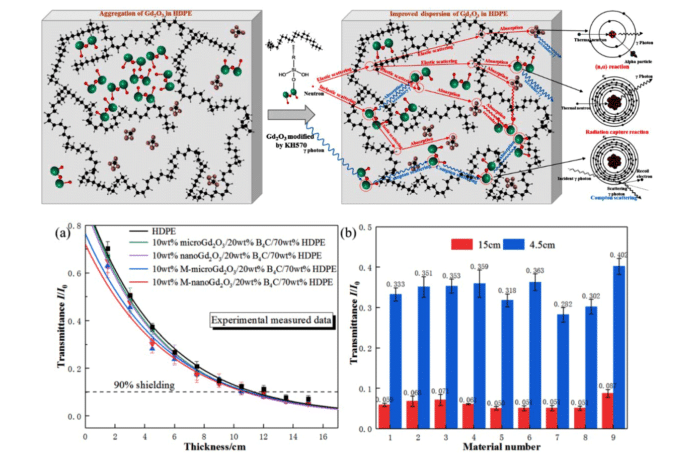Neutron shielding materials are essential components for radiation protection in many nuclear facilities. Especially in some nuclear fusion experimental devices, the diagnostic system like Neutron camera needs to install a collimated shielding shell to achieve local measurement of neutron emissivity. Such shielding materials must withstand neutron and gamma radiation for a long time in a rather harsh environment.
Due to the limitations of space and mobility, the weight and volume of radiation shielding materials are also quite restricted. Therefore, in addition to excellent shielding performance, radiation shielding materials also need mechanical durability, low specific gravity, small volume, long service life, and other properties.
Dr. HUO Zhipeng and his student ZHAO Sheng from the Hefei Institutes of physical science (HFIPS) of the Chinese Academy of Sciences recently developed a lead-free neutron and gamma-ray composite shielding material that has high shielding properties and is environmentally friendly. Their results were published on Nuclear Materials and Energy.
The composite, modified-gadolinium oxide/boron carbide/high-density polyethylene (Gd2O3/B4C/HDPE), was tested safe and effective to shield neutrons and gamma rays through a series of intricate and comprehensive experiments.
As an electrically neutral particle, Neutron has a strong penetrability and always emits secondary gamma rays during the particle collision process. The scientific and efficient scheme of shielding neutrons is to simultaneously select high Z (atomic number), low Z materials, and neutron-absorbing materials for combined shielding. However, lead-containing materials are restricted in application with biological toxicity.
Rare-earth element gadolinium usually exists in the form of non-toxic Gd2O3 in nature, has always shown high average thermal neutron absorption, high-temperature resistance, and good gamma shielding performance.
The researchers studied the shielding mechanism first and then adopted the coupling agents to modify the surface of Gd2O3 to improve the interfacial compatibility and dispersion of Gd2O3 in the matrix.
“It is lead-free and poses no threat to the environment or humans,” said Dr. HUO, who has been engaged in radiation and environmental protection for years.
He further explained how this radiation shielding system worked. Fast neutrons collide with gadolinium (Gd) inelastically and collide elastically with hydrogen until they become thermal neutrons, finally absorbed by high Z element Gd and boron.
The experimental results show that the neutron shielding rate of the composite can reach 98% under the condition of 15 cm thickness in the Cf-252 environment. In Cs-137 and Co-60 environments, the gamma shielding rates of the composite are 72% and 60%, respectively, at the same thickness.
Its comprehensive shielding performance is better than conventional boron-polyethylene collimating shielding, and it is suitable for the neutron spectrum and gamma spectrum diagnosis system of Experimental Advanced Superconducting Tokamak (EAST). According to the researchers, it is expected to be a promising radiation shielding material for neutron-gamma mixed fields.
Highlights of the study:
- A series of surface modified-gadolinium/boron/polyethylene composite was prepared.
- The modification of fillers improved the interfacial compatibility and dispersion in HDPE.
- The neutron and gamma shielding performance were significantly improved by modification.
Journal Reference
- Zhipeng Huo, Sheng Zhao, Guoqiang Zhong, Hong Zhang, Liqun Hu; Surface modified-gadolinium/boron/polyethylene composite with high shielding performance for neutron and gamma-ray. Volume 29, 2021, DOI: 10.1016/j.nme.2021.101095
